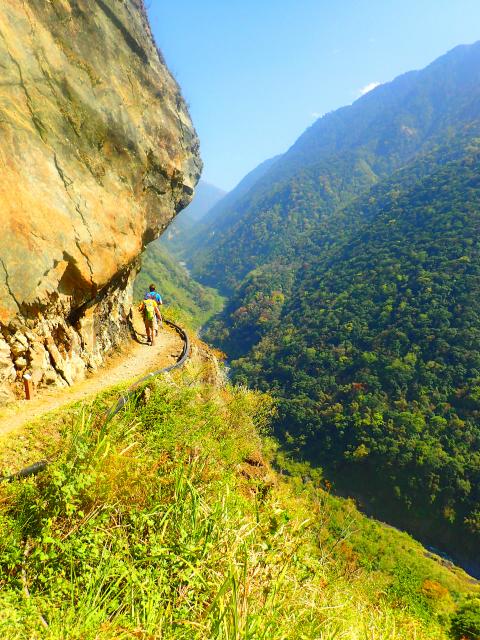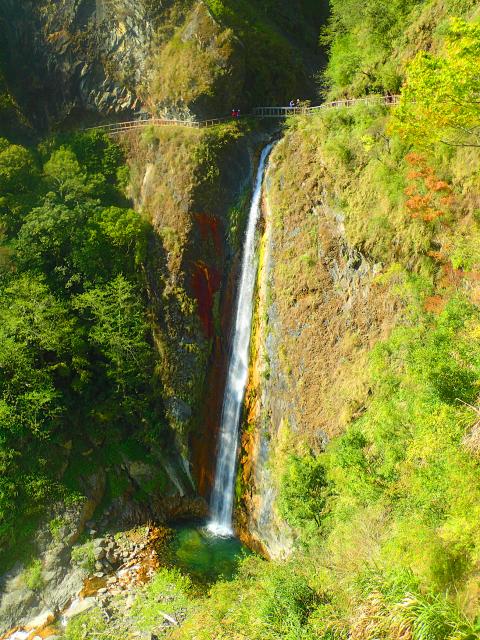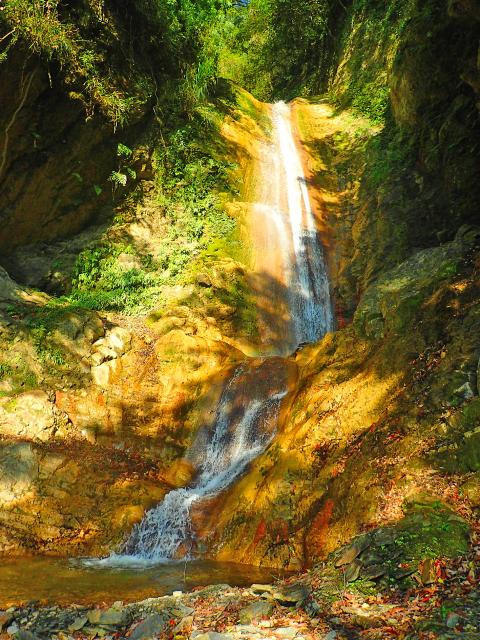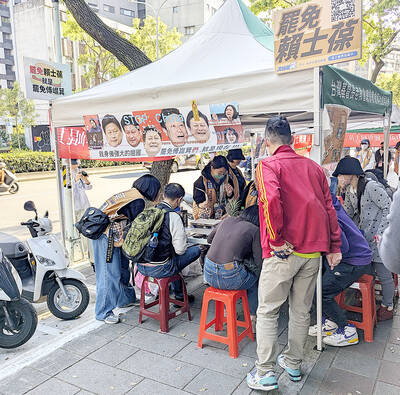Sweeping statement time: the westernmost section of the Batongguan Historic Trail (八通關古道) in Nantou County is hands down one of Taiwan’s finest day hikes (and there are hot springs to enjoy afterwards to boot). Very few other trails in Taiwan command such incredible views for so little effort. Quite simply, it’s one hike everyone should try to do once, although compared with other classic day hikes, such as the overrated Caoling Historic Trail (草嶺古道) in New Taipei City, remarkably few do.
Recent upgrades to this part of the historic trail have made it safe and easy for hikers of all abilities to follow, but it has a long and interesting history. The trail dates back to the Qing dynasty. Even after Qing rulers annexed Taiwan in 1683, the island was for a long time considered of little importance, even being famously described as “a ball of mud” by the Kangxi emperor (reigned 1661-1722).
VIOLENT HISTORY

Photo: Richard Saunders
After Han settlement started increasing in the early 1700s, immigrants occupied the fertile western plains, forcing the island’s indigenous inhabitants into the mountains. Despite efforts to keep the island’s Han and Aboriginal peoples apart, conflicts occurred. Things came to a head with the killing in 1871 of over 50 Japanese sailors by Paiwan Aborigines, in what became known as the Mudan Incident (牡丹社事件).
The Qing government (as it turned out only-too-rightly fearful of incursions by Japan, under the pretense of punishing the offenders) set about placating the Japanese by opening up the island’s inaccessible interior and suppressing the Aboriginal inhabitants. The original Batongguan Trail was the longest of the three cross-island routes established to provide access to the north, center and south of the island’s interior. These new communication routes managed to keep the Aborigines in check to an extent, but two decades later, Japan still found an excuse to colonize the island.
The original trail stretched 152km and was apparently completed by 2,000 soldiers in the amazing space of just one year. The trail that we follow today, correctly known as the Batongguan Traversing Trail (八通關越嶺古道) is a later construction, built by the Japanese between 1919 and 1921 for the same reason — to subjugate the Aboriginal inhabitants. Leaving the hotspring town of Dongpu (東埔), the two routes are largely the same, but further east they diverge quite widely.

Photo: Richard Saunders
HIKING THE TRAIL
Start out at Dongpu Hot Springs (東埔溫泉), an area of hotels and modest resorts perched on the side of a deep valley below the looming peaks of the Yushan Mountain Range (玉山山脈). It’s a comfortable place to spend the night, and although the walk can be completed in half a day, it’s worth spending the night before in Dongpu and setting off early the following morning, when the weather is more likely to be clear.
The three-hour walk from Dongpu village to Yinu Waterfall (乙女瀑布) begins with a short road walk up the main street through the hot spring resort. Pass through a tunnel, ignore the old trailhead on the left, which has now been closed, and walk another five minutes to the start of the path, a steep concrete lane marked by an info board.

Photo: Richard Saunders
The lane climbs stiffly at first, giving a panoramic view over Dongpu, the river valley below and (rising behind) the summits of Yushan Front (玉山前峰; 3,239 meters) and West (玉山西峰3,518 meters) peaks. After an area of snack stands (which set up daily beside the trail) the route climbs around the side of the crumbling, slippery face of Father & Son Cliff (父不知子斷崖).
Back in the 1990s, on my first visit, this was still a particularly precarious stretch of the trail, cut into the sheer rock face. Much improved after being nearly destroyed by Typhoon Morakot in 2009, the trail is wide and safe, with rugged iron tube barriers to dissuade the careless from falling over the brink.
CLOUD DRAGON WATERFALL
From here to Cloud Dragon Waterfall (雲龍瀑布), much of the trail is cut into the sheer cliff, with a breathtaking drop into the gorge far, far below, punctuated by short sections where the mountain gradient becomes gentle enough to support pockets of forest. Four kilometers (about two hours) from the trailhead, Cloud Dragon Waterfall plunges in two spectacular leaps, both invisible from the trail until the last moment. The upper fall can be enjoyed from the bridge across the stream below. To see the much higher and more spectacular lower fall, walk to the suspension bridge, another hundred meters or so further.
After Cloud Dragon Waterfall, the trail disappears into the woods, the terrain becomes less precipitous and there are only occasional views over the great gorge below. Paradoxically, though, the hiking becomes a bit more taxing. About 40 minutes past the waterfall, the trail passes a trekkers’ shelter called Lele Cabin (樂樂山屋), standing on the site of a former Japanese police substation.
Beyond the hut the trail soon emerges from the trees, and there are views across to a stream plunging in multiple cascades down the mountainside at Yinu Waterfall (about six kilometers from the trailhead). The trail crosses the stream by an iron footbridge just below a particularly fine fall in the series; the rocky scree at its base is a great place to stop, relax and enjoy the beauty of the scene before contemplating the walk back to Dongpu.
Beyond Yinu Waterfall, the Batongguan Trail continues to climb to Guangao (觀高). For day trippers, though, the best is over (and you definitely need permits to go any further), so turn round and start the walk back to Dongpu.
There-and-back walks almost never finish as well as they start, but with a whole new set of panoramas unfolding on the return journey, the walk back this time is every bit as enjoyable as the outward route. Just hope for clear weather.
Richard Saunders is a classical pianist and writer who has lived in Taiwan since 1993. He’s the founder of a local hiking group, Taipei Hikers, and is the author of six books about Taiwan, including Taiwan 101 and Taipei Escapes. Visit his Web site at www.taiwanoffthebeatentrack.com.

That US assistance was a model for Taiwan’s spectacular development success was early recognized by policymakers and analysts. In a report to the US Congress for the fiscal year 1962, former President John F. Kennedy noted Taiwan’s “rapid economic growth,” was “producing a substantial net gain in living.” Kennedy had a stake in Taiwan’s achievements and the US’ official development assistance (ODA) in general: In September 1961, his entreaty to make the 1960s a “decade of development,” and an accompanying proposal for dedicated legislation to this end, had been formalized by congressional passage of the Foreign Assistance Act. Two

Despite the intense sunshine, we were hardly breaking a sweat as we cruised along the flat, dedicated bike lane, well protected from the heat by a canopy of trees. The electric assist on the bikes likely made a difference, too. Far removed from the bustle and noise of the Taichung traffic, we admired the serene rural scenery, making our way over rivers, alongside rice paddies and through pear orchards. Our route for the day covered two bike paths that connect in Fengyuan District (豐原) and are best done together. The Hou-Feng Bike Path (后豐鐵馬道) runs southward from Houli District (后里) while the

On March 13 President William Lai (賴清德) gave a national security speech noting the 20th year since the passing of China’s Anti-Secession Law (反分裂國家法) in March 2005 that laid the legal groundwork for an invasion of Taiwan. That law, and other subsequent ones, are merely political theater created by the Chinese Communist Party (CCP) to have something to point to so they can claim “we have to do it, it is the law.” The president’s speech was somber and said: “By its actions, China already satisfies the definition of a ‘foreign hostile force’ as provided in the Anti-Infiltration Act, which unlike

Mirror mirror on the wall, what’s the fairest Disney live-action remake of them all? Wait, mirror. Hold on a second. Maybe choosing from the likes of Alice in Wonderland (2010), Mulan (2020) and The Lion King (2019) isn’t such a good idea. Mirror, on second thought, what’s on Netflix? Even the most devoted fans would have to acknowledge that these have not been the most illustrious illustrations of Disney magic. At their best (Pete’s Dragon? Cinderella?) they breathe life into old classics that could use a little updating. At their worst, well, blue Will Smith. Given the rapacious rate of remakes in modern